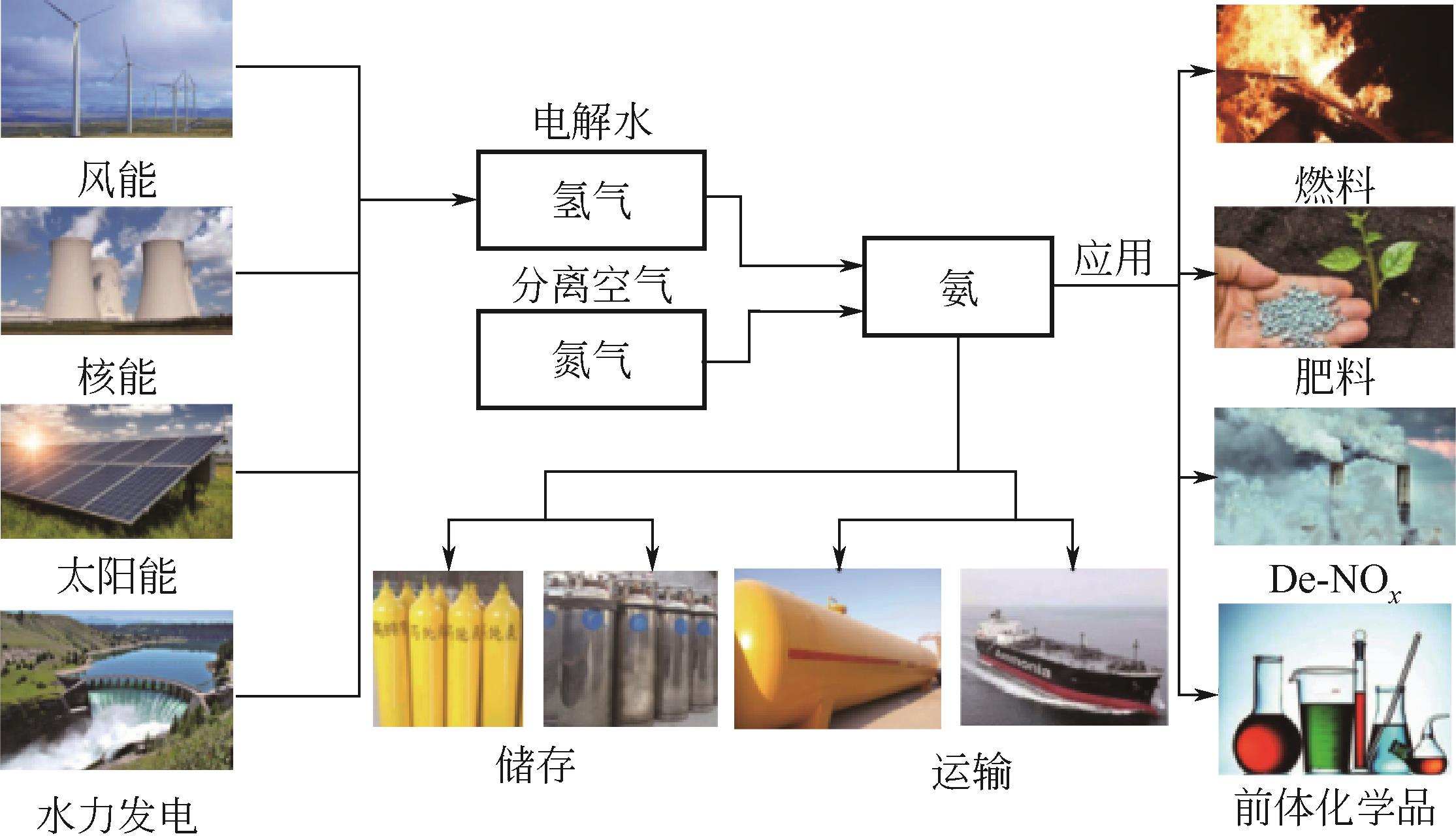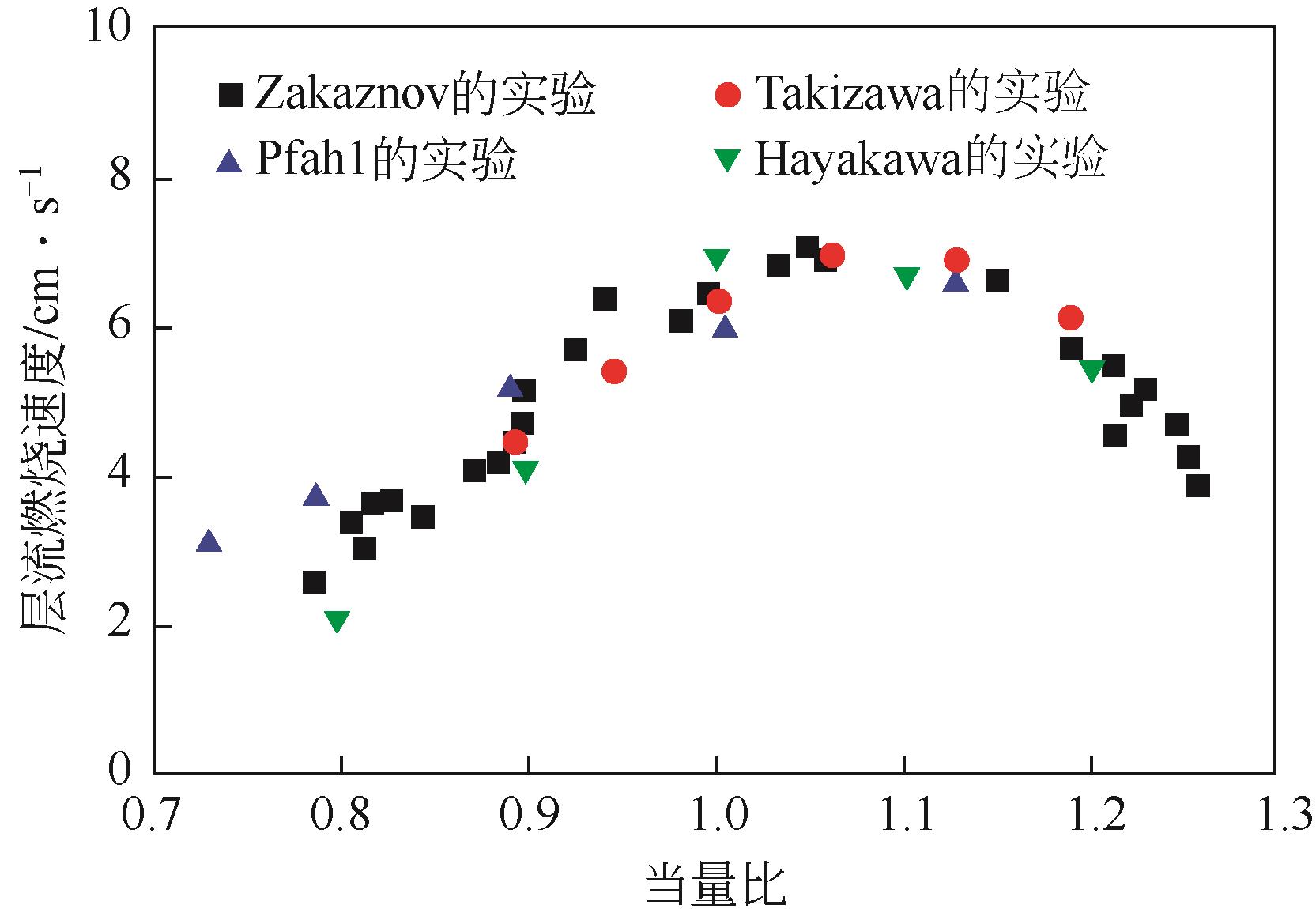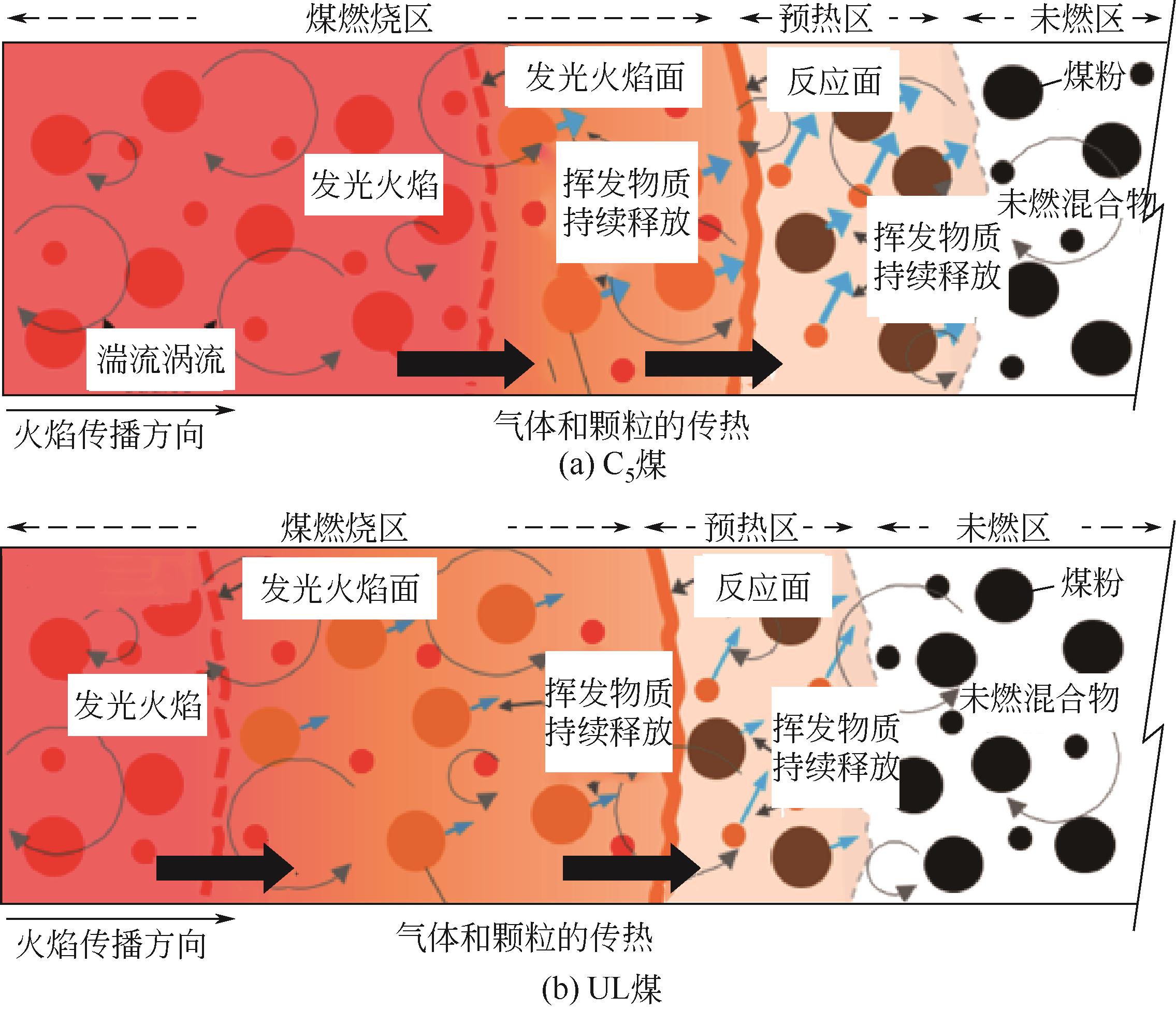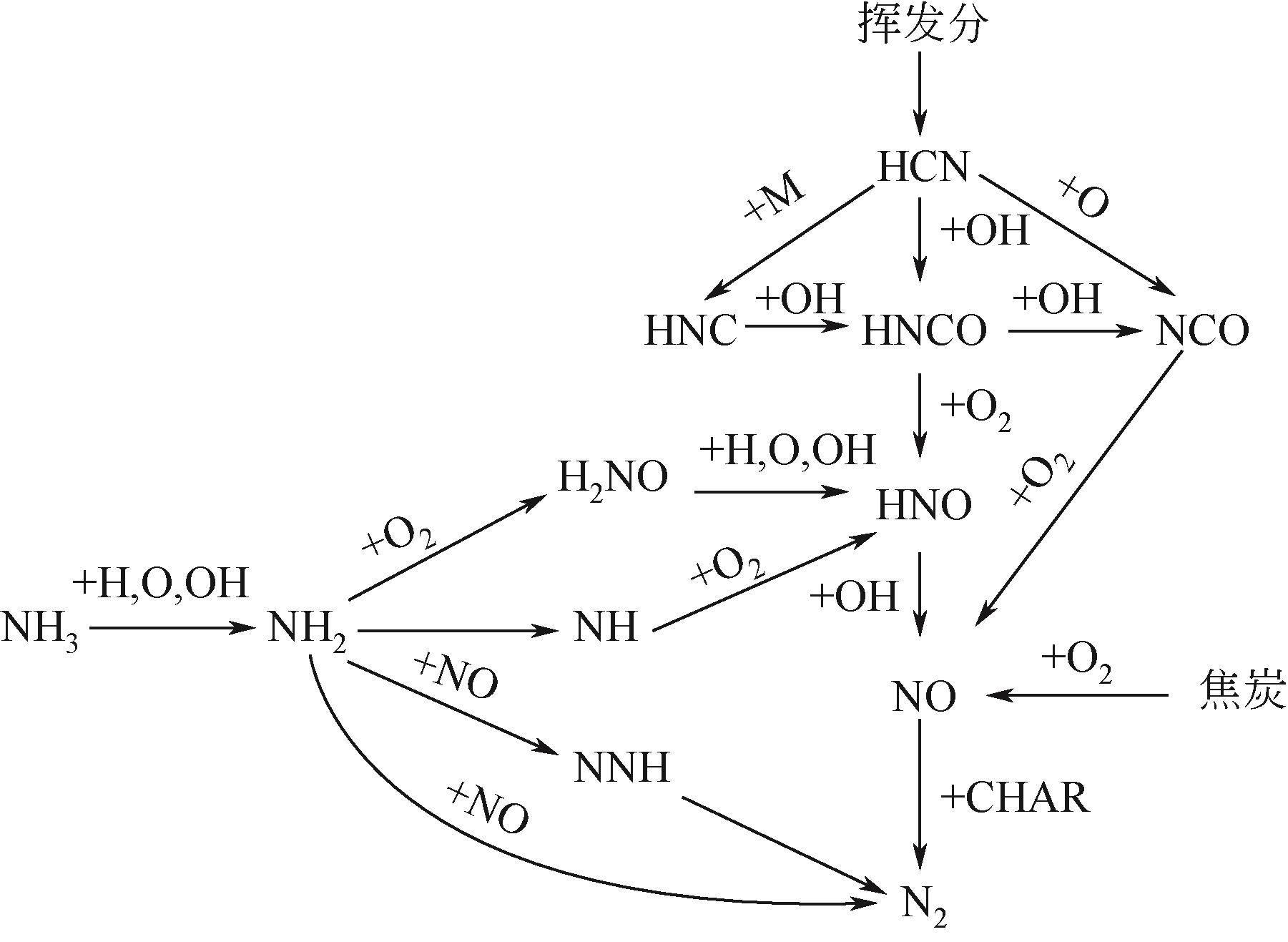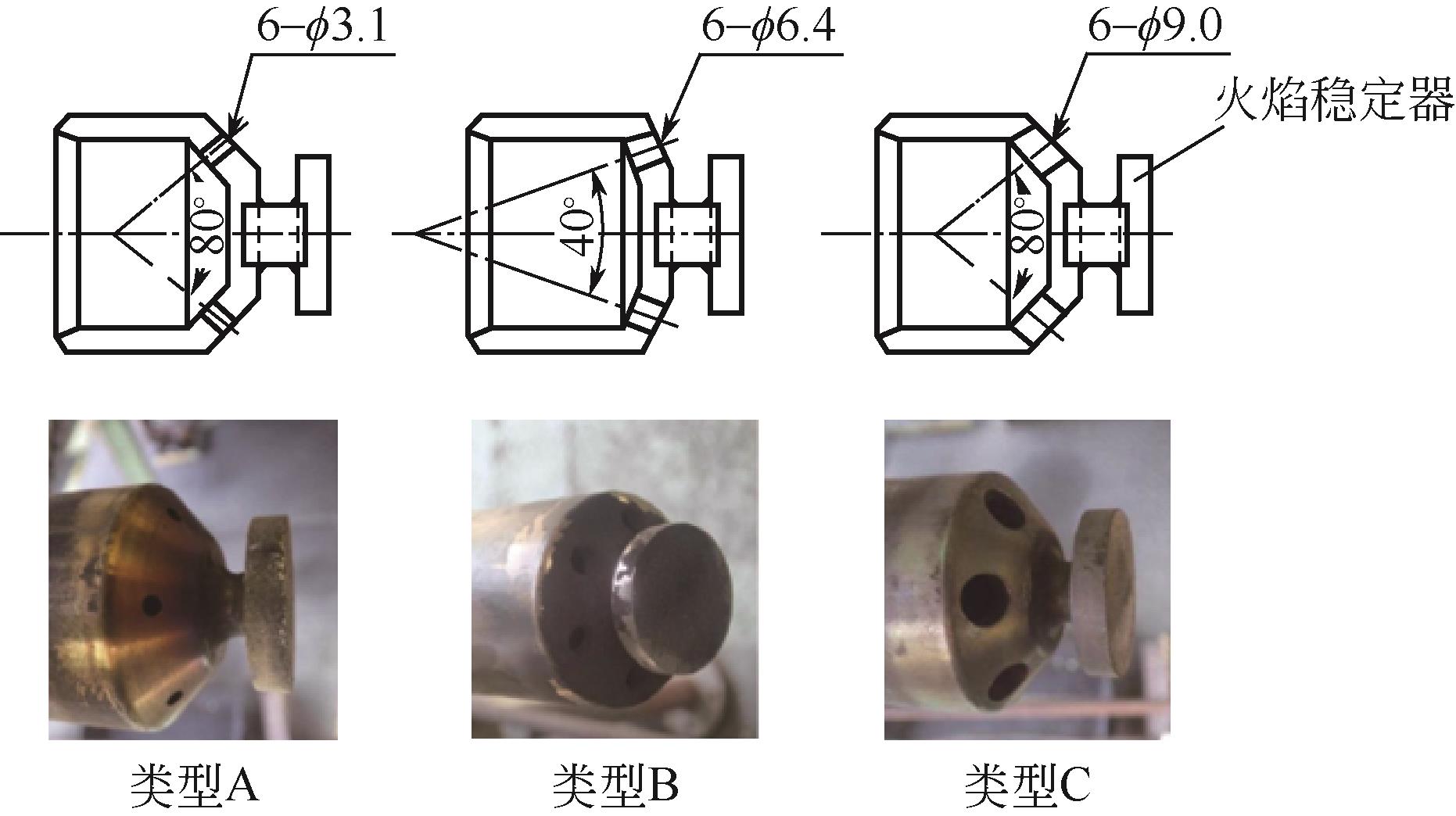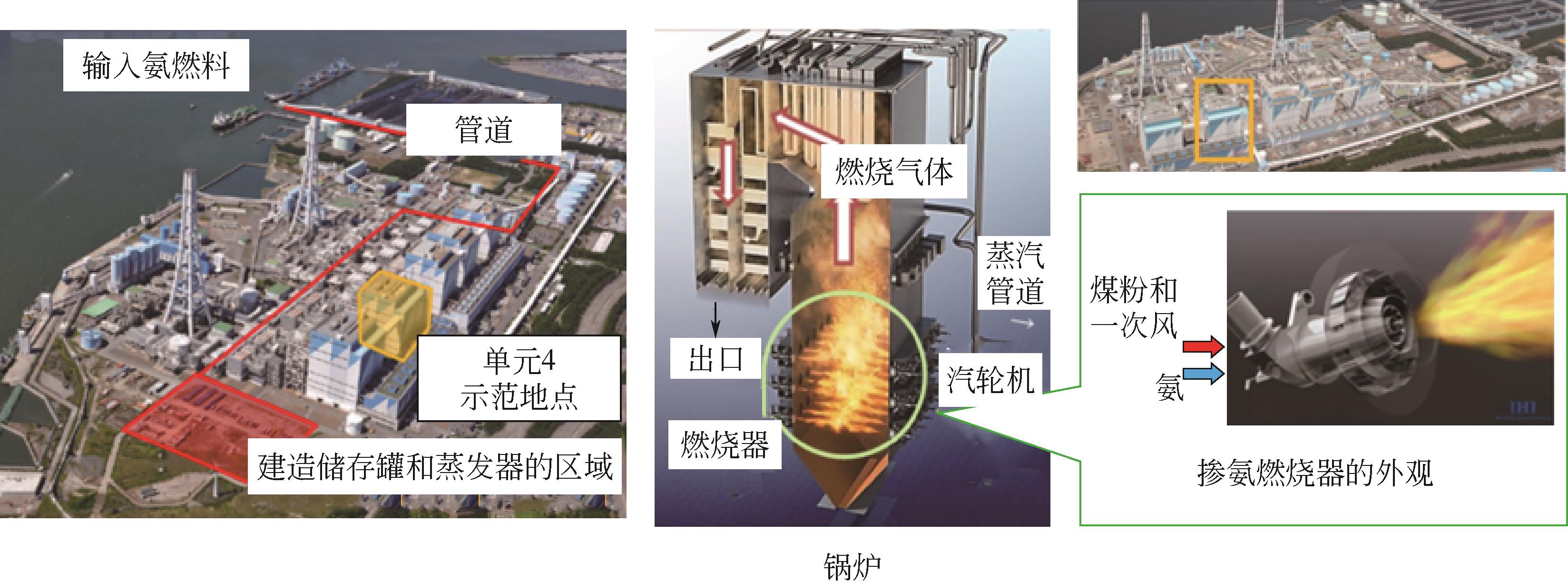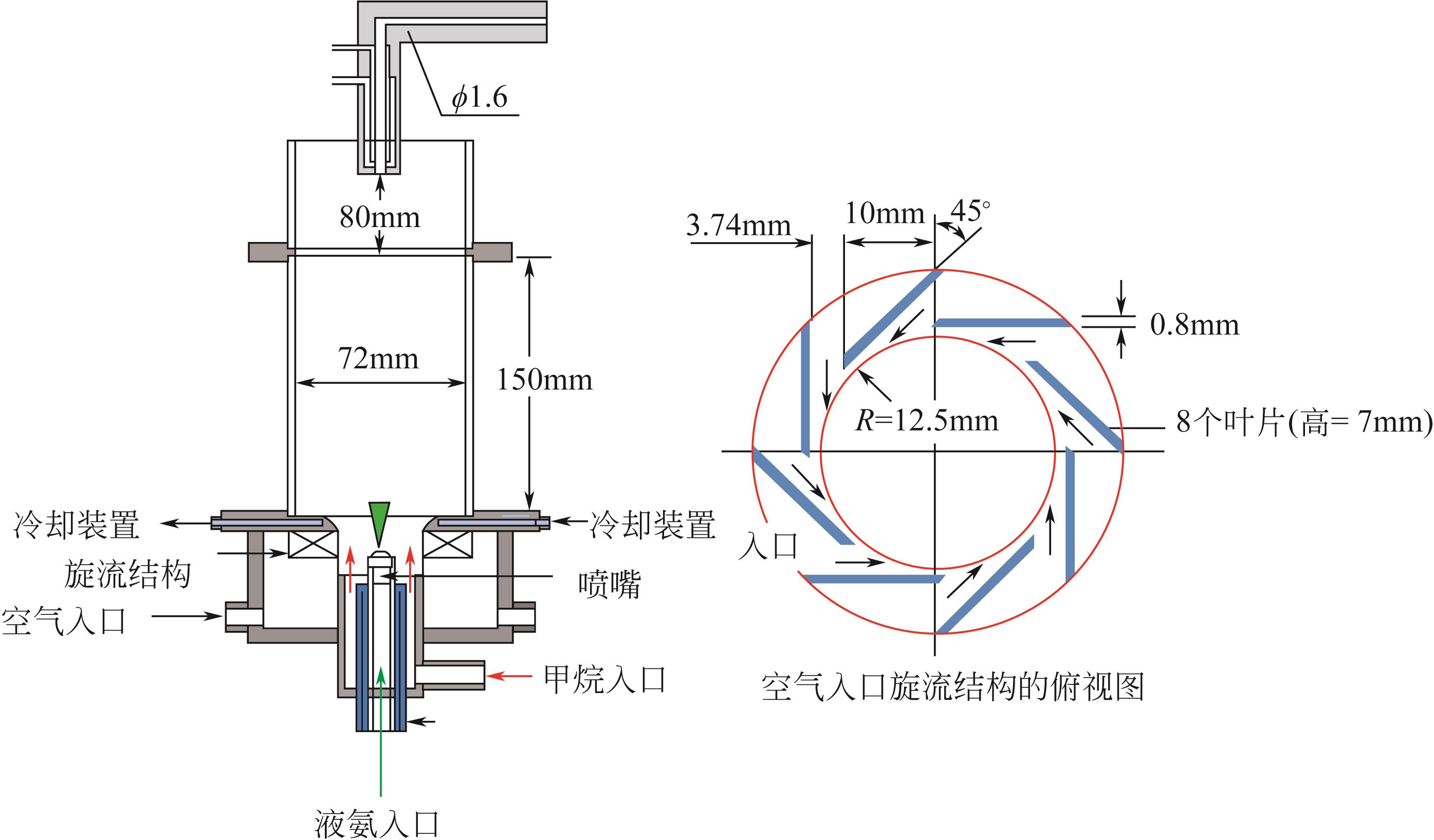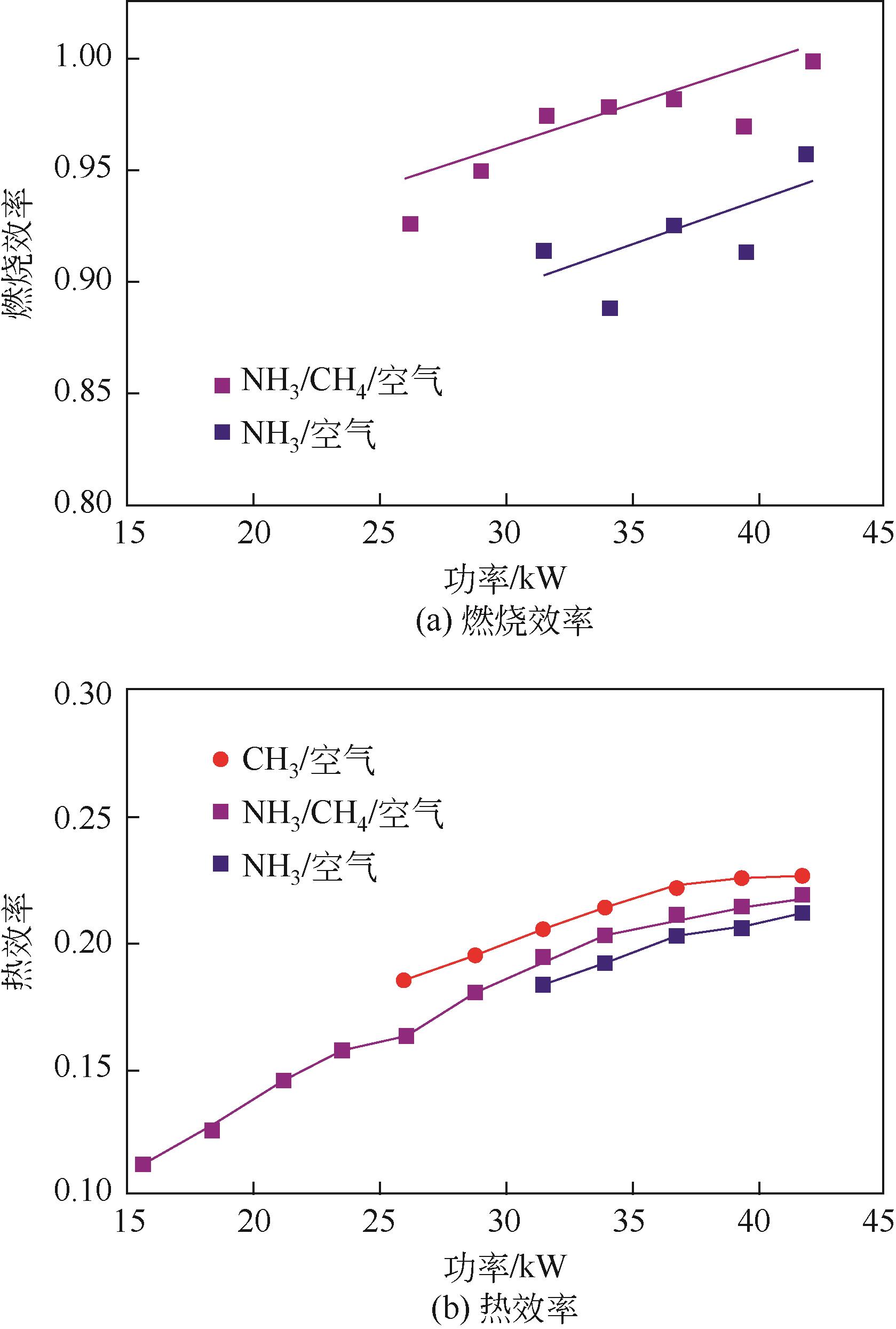化工进展 ›› 2023, Vol. 42 ›› Issue (9): 4603-4615.DOI: 10.16085/j.issn.1000-6613.2022-2005
含碳掺氨燃料的研究进展
赖诗妮1,2( ), 江丽霞3, 李军1,2,4,5(
), 江丽霞3, 李军1,2,4,5( ), 黄宏宇1,2,5, 小林敬幸6
), 黄宏宇1,2,5, 小林敬幸6
- 1.中国科学院广州能源研究所,广东 广州 510640
2.中国科学技术大学能源科学与技术学院,广东 广州 510640
3.中国科学院重大科技任务局,北京 100864
4.江西省碳中和研究中心,江西 南昌 330096
5.南方海洋科学与工程广东省实验室(广州),广东 广州 511458
6.名古屋大学化学系统工程系,日本 名古屋 464-8603
-
收稿日期:2022-10-27修回日期:2022-11-29出版日期:2023-09-15发布日期:2023-09-28 -
通讯作者:李军 -
作者简介:赖诗妮(1999—),女,硕士研究生,研究方向为氨基燃料燃烧。E-mail:sa21178008@mail.ustc.edu.cn。 -
基金资助:南方海洋科学与工程广东省实验室(广州)人才团队引进重大专项(GML2019ZD0108);广东省重点领域研发计划(2020B0202010004)
Research progress of ammonia blended fossil fuel
LAI Shini1,2( ), JIANG Lixia3, LI Jun1,2,4,5(
), JIANG Lixia3, LI Jun1,2,4,5( ), HUANG Hongyu1,2,5, KOBAYASHI Noriyuki6
), HUANG Hongyu1,2,5, KOBAYASHI Noriyuki6
- 1.Guangzhou Institute of Energy Conversion, Chinese Academy of Sciences, Guangzhou 510640, Guangdong, China
2.School of Energy Science and Engineering, University of Science and Technology of China, Guangzhou 510640, Guangdong, China
3.Bureau of Major R&D Programs, Chinese Academy of Sciences, Beijing 100864, China
4.Jiangxi Carbon Neutralization Research Center, Nanchang 330096, Jiangxi, China
5.Southern Marine Science and Engineering Guangdong Laboratory (Guangzhou), Guangzhou 511458, Guangdong, China
6.Department of Chemical Systems Engineering, Nagoya University, Nagoya 464-8603, Japan
-
Received:2022-10-27Revised:2022-11-29Online:2023-09-15Published:2023-09-28 -
Contact:LI Jun
摘要:
随着经济和社会的发展,国家对能源的需求量越来越大,这与化石能源短缺、环境污染、温室效应等问题相矛盾,因此寻找高效清洁的替代燃料势在必行。氨的体积能量密度较高、成本低且完全燃烧时产物的污染性小,具有成为新时代绿色能源的潜力。但它的燃烧性能较差,通常需要掺混煤、CH4和合成气等燃料来改善。本文主要介绍了含碳掺氨的煤掺氨和甲烷掺氨混合燃料在基础燃烧特性和燃烧应用优化方面的研究进展。总结了不同燃烧策略及燃烧器设计中掺混氨燃料的燃烧特性和排放规律,为未来工业化应用研究提供一定的参考。但在实际应用氨燃料过程中仍存在不少挑战,未来可进一步对优化分级燃烧的策略、改善相关燃烧设备的结构、调整含氨燃料的喷射方式等方面进行研究,以实现高效低污染氨燃料的应用目标。
中图分类号:
引用本文
赖诗妮, 江丽霞, 李军, 黄宏宇, 小林敬幸. 含碳掺氨燃料的研究进展[J]. 化工进展, 2023, 42(9): 4603-4615.
LAI Shini, JIANG Lixia, LI Jun, HUANG Hongyu, KOBAYASHI Noriyuki. Research progress of ammonia blended fossil fuel[J]. Chemical Industry and Engineering Progress, 2023, 42(9): 4603-4615.
| 年份 | 传统能源占能源消费总量的比重/% | ||
|---|---|---|---|
| 煤炭 | 石油 | 天然气 | |
| 2020年 | 56.8 | 18.9 | 8.4 |
| 2019年 | 57.7 | 19.0 | 8.0 |
| 2018年 | 59.0 | 18.9 | 7.6 |
| 2017年 | 60.6 | 18.9 | 6.9 |
| 2016年 | 62.2 | 18.7 | 6.1 |
表1 2015—2020年的能源消费情况[2]
| 年份 | 传统能源占能源消费总量的比重/% | ||
|---|---|---|---|
| 煤炭 | 石油 | 天然气 | |
| 2020年 | 56.8 | 18.9 | 8.4 |
| 2019年 | 57.7 | 19.0 | 8.0 |
| 2018年 | 59.0 | 18.9 | 7.6 |
| 2017年 | 60.6 | 18.9 | 6.9 |
| 2016年 | 62.2 | 18.7 | 6.1 |
| 性能 | 数值 | |||
|---|---|---|---|---|
| 氨 | 氢 | 甲烷 | 甲醇 | |
| 含氢质量分数/% | 17.8 | 100 | 25.0 | 12.5 |
| 密度/kg·m-3 | 0.8 | 0.09 | 0.7 | 786.0 (液态) |
| 低位质量热值/MJ·kg-1 | 18.8 | 120.0 | 50.1 | 19.7 |
| 低位体积热值/MJ·m-3 | 14.3 | 10.8 | 35.9 | — |
| 常压液化压力/MPa | 0.8 | 70.0 | 25.0 | 0.1 |
| 自燃点/℃ | 651 | 500~557 | 586 | 470 |
| 辛烷值 | 130 | >130 | 120 | 109 |
表2 氨与其他燃料的性能对比[21]
| 性能 | 数值 | |||
|---|---|---|---|---|
| 氨 | 氢 | 甲烷 | 甲醇 | |
| 含氢质量分数/% | 17.8 | 100 | 25.0 | 12.5 |
| 密度/kg·m-3 | 0.8 | 0.09 | 0.7 | 786.0 (液态) |
| 低位质量热值/MJ·kg-1 | 18.8 | 120.0 | 50.1 | 19.7 |
| 低位体积热值/MJ·m-3 | 14.3 | 10.8 | 35.9 | — |
| 常压液化压力/MPa | 0.8 | 70.0 | 25.0 | 0.1 |
| 自燃点/℃ | 651 | 500~557 | 586 | 470 |
| 辛烷值 | 130 | >130 | 120 | 109 |
| 反应式 | A/s-1 | β | Ea/J·kmol-1 | 参考文献 |
|---|---|---|---|---|
| C m H n +(m/2)O2 | 4.4×1011 | 0 | 1.26×108 | [ |
| C m H n +mH2O | 3.0×108 | 0 | 1.26×108 | [ |
| Tar(C x H y O2)+0.5(z-x)O2 | 6.57×105 | 1 | 8.02×107 | [ |
| Char(C412N5)+208.5O2 | 3.45×1011 | 0 | 1.25×108 | [ |
| Char(C412N5)+NO | 2.36×107 | 0 | 1.12×108 | [ |
| Soot(C166)+NO | 2.41×1012 | 0.5 | 1.25×108 | [ |
| H2+0.5O2 | 5.69×1011 | 0 | 1.47×108 | [ |
| CO+H2O | 2.75×109 | 0 | 8.36×107 | [ |
| CO+0.5O2 | 1.93×1013 | -2 | 1.26×108 | [ |
| NH3+O2 | 3.5×102 | 7.65 | 5.24×108 | [ |
| NH3+NO | 4.24×105 | 5.3 | 3.5×108 | [ |
| NH3 | 0.185 | 1.25 | 6.9×107 | [ |
表3 煤掺氨过程主要反应及部分动力学参数
| 反应式 | A/s-1 | β | Ea/J·kmol-1 | 参考文献 |
|---|---|---|---|---|
| C m H n +(m/2)O2 | 4.4×1011 | 0 | 1.26×108 | [ |
| C m H n +mH2O | 3.0×108 | 0 | 1.26×108 | [ |
| Tar(C x H y O2)+0.5(z-x)O2 | 6.57×105 | 1 | 8.02×107 | [ |
| Char(C412N5)+208.5O2 | 3.45×1011 | 0 | 1.25×108 | [ |
| Char(C412N5)+NO | 2.36×107 | 0 | 1.12×108 | [ |
| Soot(C166)+NO | 2.41×1012 | 0.5 | 1.25×108 | [ |
| H2+0.5O2 | 5.69×1011 | 0 | 1.47×108 | [ |
| CO+H2O | 2.75×109 | 0 | 8.36×107 | [ |
| CO+0.5O2 | 1.93×1013 | -2 | 1.26×108 | [ |
| NH3+O2 | 3.5×102 | 7.65 | 5.24×108 | [ |
| NH3+NO | 4.24×105 | 5.3 | 3.5×108 | [ |
| NH3 | 0.185 | 1.25 | 6.9×107 | [ |
| 模型 | 燃料类型 | 组分/反应的数目 | 模拟结果 | 参考文献 |
|---|---|---|---|---|
| GRI 3.0 | 天然气 | 53/325 | 可用于高压燃烧条件的模拟;不包括涉及N2H2和N2H3中间产物的所有反应,模拟的层流火焰速度比实验值低;贫燃条件下NO x 模拟值偏高 | [ |
| San Diego | 天然气 | 20/41 | 可用于高压燃烧条件的模拟;能准确预测旋流火焰中的NO x 和NH3排放 | [ |
| Konnov | NH3/CH4 | 129/1231 | 能较好地模拟甲烷含量高时燃料的层流火焰速度;高压条件下的点火延迟时间和NO、CO排放模拟结果良好 | [ |
| Tian | NH3/CH4 | 84/703 | 适用于低压燃烧条件的模拟[ | [ |
| Okafor | NH3/CH4 | 59/356 | 适用于低压的燃烧条件[ | [ |
表4 甲烷掺氨部分反应机理及适用情况
| 模型 | 燃料类型 | 组分/反应的数目 | 模拟结果 | 参考文献 |
|---|---|---|---|---|
| GRI 3.0 | 天然气 | 53/325 | 可用于高压燃烧条件的模拟;不包括涉及N2H2和N2H3中间产物的所有反应,模拟的层流火焰速度比实验值低;贫燃条件下NO x 模拟值偏高 | [ |
| San Diego | 天然气 | 20/41 | 可用于高压燃烧条件的模拟;能准确预测旋流火焰中的NO x 和NH3排放 | [ |
| Konnov | NH3/CH4 | 129/1231 | 能较好地模拟甲烷含量高时燃料的层流火焰速度;高压条件下的点火延迟时间和NO、CO排放模拟结果良好 | [ |
| Tian | NH3/CH4 | 84/703 | 适用于低压燃烧条件的模拟[ | [ |
| Okafor | NH3/CH4 | 59/356 | 适用于低压的燃烧条件[ | [ |
| 燃烧器结构 | 燃烧方式 | 运行条件 | 旋流数 | 参考文献 |
|---|---|---|---|---|
| 同轴双旋流+钝体 | 预混燃烧 | 外侧旋流燃烧器: 贫预混的CH4/空气混合物; 当量比为0.6~0.7 内侧旋流燃烧器: 掺氨比为0%~100%的CH4/NH3燃料; 当量比为0.2~1.4 | 外侧叶片:0.84 内侧叶片:0.72 | [ |
| 单旋流+同轴环状燃料入口 | 预混燃烧+非预混燃烧 | 掺氨比为0%~30%的CH4/NH3燃料; 当量比为0.8~1.1 | 0.88 | [ |
| 单旋流+钝体 | 预混燃烧 | 掺氨比为0%~60%的CH4/NH3燃料; 当量比为0.56~0.74 | 0.42、0.73和1.27 | [ |
| 切向涡流燃烧器 | 预混燃烧 | 61% NH3/39% CH4; 当量比为0.8~1.42 | 1.33 | [ |
单旋流+同轴双燃料入口 (中间入口喷入液氨) | 非预混燃烧 | 掺氨比为70%~100%的液氨/气态CH4; 当量比为0.66~1.37 | 2.34 | [ |
表5 甲烷掺氨的旋流燃烧器设计方案
| 燃烧器结构 | 燃烧方式 | 运行条件 | 旋流数 | 参考文献 |
|---|---|---|---|---|
| 同轴双旋流+钝体 | 预混燃烧 | 外侧旋流燃烧器: 贫预混的CH4/空气混合物; 当量比为0.6~0.7 内侧旋流燃烧器: 掺氨比为0%~100%的CH4/NH3燃料; 当量比为0.2~1.4 | 外侧叶片:0.84 内侧叶片:0.72 | [ |
| 单旋流+同轴环状燃料入口 | 预混燃烧+非预混燃烧 | 掺氨比为0%~30%的CH4/NH3燃料; 当量比为0.8~1.1 | 0.88 | [ |
| 单旋流+钝体 | 预混燃烧 | 掺氨比为0%~60%的CH4/NH3燃料; 当量比为0.56~0.74 | 0.42、0.73和1.27 | [ |
| 切向涡流燃烧器 | 预混燃烧 | 61% NH3/39% CH4; 当量比为0.8~1.42 | 1.33 | [ |
单旋流+同轴双燃料入口 (中间入口喷入液氨) | 非预混燃烧 | 掺氨比为70%~100%的液氨/气态CH4; 当量比为0.66~1.37 | 2.34 | [ |
| 1 | Nejat VEZIROĞLU T, Sümer ŞAHI’N. 21st Century’s energy: Hydrogen energy system[J]. Energy Conversion and Management, 2008, 49(7):1820-1831. |
| 2 | 国家统计局. 能源消费总量[EB/OL]. (2021-11-29)[2022-10-24]. . |
| State Statistical Bureau. Total energy consumed[EB/OL]. (2021-11-29)[2022-10-24]. . | |
| 3 | 新华网. 政府工作报告[EB/OL].(2021-03-12)[2022-11-01]. . |
| Net Xinhua. Report on the work of the goverment[EB/OL]. (2021-03-12)[2022-11-01]. . | |
| 4 | 吴梦茜. 大规模液氢泄漏扩散的数值模拟与影响因素分析[D]. 杭州: 浙江大学, 2017. |
| WU Mengxi. CFD modeling and influence factor analyzing of large-scale liquid hydrogen spills[D]. Hangzhou: Zhejiang University, 2017. | |
| 5 | ZAMFIRESCU C, DINCER I. Using ammonia as a sustainable fuel[J]. Journal of Power Sources, 2008, 185(1): 459-465. |
| 6 | CHRISTENSEN Claus Hviid, JOHANNESSEN Tue, SøRENSEN Rasmus Zink, et al. Towards an ammonia-mediated hydrogen economy?[J]. Catalysis Today, 2006, 111(1/2): 140-144. |
| 7 | ZHOU Mei, WANG Yuegu, CHU Yuchun, et al. Ammonia as an environmentally benign energy carrier for the fast growth of China[J]. Energy Procedia, 2019, 158: 4986-4991. |
| 8 | Natalia MORLANÉS, KATIKANENI Sai P, PAGLIERI Stephen N, et al. A technological roadmap to the ammonia energy economy: Current state and missing technologies[J]. Chemical Engineering Journal, 2021, 408:127310. |
| 9 | 高正平, 涂安琪, 李天新, 等. 面向零碳电力的氨燃烧技术研究进展[J]. 洁净煤技术, 2022, 28(3): 173-184. |
| GAO Zhengping, TU Anqi, LI Tianxin, et al. Recent advances on ammonia combustion technology for zero-carbon power[J]. Clean Coal Technology, 2022, 28(3): 173-184. | |
| 10 | 周上坤, 杨文俊, 谭厚章, 等. 氨燃烧研究进展[J]. 中国电机工程学报, 2021, 41(12): 4164-4181. |
| ZHOU Shangkun, YANG Wenjun, TAN Houzhang, et al. Research progress of ammonia combustion[J]. Proceedings of the CSEE, 2021, 41(12): 4164-4181. | |
| 11 | International Renewable Energy Agency. World energy transitions outlook: 1.5℃pathway[EB/OL].[2022-06-11]. . |
| 12 | LEE Hookyung, LEE Min-Jung. Recent advances in ammonia combustion technology in thermal power generation system for carbon emission reduction[J]. Energies, 2021, 14(18): 5604. |
| 13 | BUTLER Melissa Oellerich, THOMPSON Adrienne. House introduces CLEAN future act—A comprehensive bill to achieve a net zero greenhouse gas economy by 2050[EB/OL]. (2021-03-15)[2022-09-15]. . |
| 14 | SERVICE Robert F. Ammonia—A renewable fuel made from sun, air, and water—Could power the globe without carbon [EB/OL]. (2021-07-12) [2022-10-10]. . |
| 15 | VALERA-MEDINA A, XIAO H, OWEN-JONES M, et al. Ammonia for power[J]. Progress in Energy and Combustion Science, 2018, 69:63-102. |
| 16 | SIDDIQUI O, DINCER I. A new solar energy system for ammonia production and utilization in fuel cells[J]. Energy Conversion and Management, 2020, 208: 112590. |
| 17 | TUKENMEZ Nejat, Murat KOC, OZTURK Murat. A novel combined biomass and solar energy conversion-based multigeneration system with hydrogen and ammonia generation[J]. International Journal of Hydrogen Energy, 2021, 46(30):16319-16343. |
| 18 | BICER Yusuf, KHALID Farrukh, MOHAMED Amro M O, et al. Electrochemical modelling of ammonia synthesis in molten salt medium for renewable fuel production using wind power[J]. International Journal of Hydrogen Energy, 2020, 45(60): 34938-34948. |
| 19 | DIMITRIOU Pavlos, JAVAID Rahat. A review of ammonia as a compression ignition engine fuel[J]. International Journal of Hydrogen Energy, 2020, 45(11): 7098-7118. |
| 20 | GUO Yuqi, PAN Zhefei, AN Liang. Carbon-free sustainable energy technology: Direct ammonia fuel cells[J]. Journal of Power Sources, 2020, 476: 228454. |
| 21 | SONKER Muskan, TIWARY Saurabh Kr, SHREYASH Nehil, et al. Ammonia as an alternative fuel for vehicular applications: Paving the way for adsorbed ammonia and direct ammonia fuel cells[J]. Journal of Cleaner Production, 2022, 376: 133960. |
| 22 | 赵康. 车载液氢汽化器换热研究[D]. 北京: 中国航天科技集团公司第一研究院, 2018. |
| ZHAO Kang. Study on heat transfer of liquid hydrogen vaporizer in vehicle[D]. Beijing: The First Academy of China Aerospace Science and Technology Corporation, 2018. | |
| 23 | ZAMFIRESCU C, DINCER I. Ammonia as a green fuel and hydrogen source for vehicular applications[J]. Fuel Processing Technology, 2009, 90(5):729-737. |
| 24 | BICER Yusuf, DINCER Ibrahim. Environmental impact categories of hydrogen and ammonia driven transoceanic maritime vehicles: A comparative evaluation[J]. International Journal of Hydrogen Energy, 2018, 43(9): 4583-4596. |
| 25 | LESMANA Herry, ZHANG Zhezi, LI Xianming, et al. NH3 as a transport fuel in internal combustion engines: A technical review[J]. Journal of Energy Resources Technology, 2019, 141(7): 070703. |
| 26 | 陈达南, 李军, 黄宏宇, 等. 氨燃烧及反应机理研究进展[J].化学通报, 2020, 83(6):508-515. |
| CHEN Danan, LI Jun, HUANG Hongyu, et al. Progress in ammonia combustion and reaction mechanism[J]. Chemistry, 2020, 83(6):508-515. | |
| 27 | HAYAKAWA Akihiro, GOTO Takashi, MIMOTO Rentaro, et al. Laminar burning velocity and Markstein length of ammonia/air premixed flames at various pressures[J]. Fuel, 2015, 159: 98-106. |
| 28 | ICHIKAWA Akinori, HAYAKAWA Akihiro, KITAGAWA Yuichi, et al. Laminar burning velocity and Markstein length of ammonia/hydrogen/air premixed flames at elevated pressures[J]. International Journal of Hydrogen Energy, 2015, 40(30): 9570-9578. |
| 29 | LI Jun, HUANG Hongyu, KOBAYASHI Noriyuki, et al. Study on using hydrogen and ammonia as fuels: Combustion characteristics and NO x formation[J]. International Journal of Energy Research, 2014, 38(9):1214-1223. |
| 30 | LI Jun, LAI Shini, CHEN Danan, et al. A review on combustion characteristics of ammonia as a carbon-free fuel[J]. Frontiers in Energy Research, 2021, 9:760356. |
| 31 | LI Jun, HUANG Hongyu, KOBAYASHI Noriyuki, et al. Numerical study on effect of oxygen content in combustion air on ammonia combustion[J]. Energy, 2015, 93:2053-2068. |
| 32 | LI Jun, HUANG Hongyu, KOBAYASHI Noriyuki, et al. Research on combustion and emission characteristics of ammonia under preheating conditions[J]. Journal of Chemical Engineering of Japan, 2016, 49(7): 641-648. |
| 33 | CHAI Wai Siong, BAO Yulei, JIN Pengfei, et al. A review on ammonia, ammonia-hydrogen and ammonia-methane fuels[J]. Renewable and Sustainable Energy Reviews, 2021, 147: 111254. |
| 34 | 徐静颖, 朱鸿玮, 徐义书,等. 燃煤电站锅炉氨燃烧研究进展及展望[J]. 华中科技大学学报(自然科学版), 2022, 50(7): 55-65. |
| XU Jingying, ZHU Hongwei, XU Yishu, et al. Research progress and prospect of ammonia cofiring in utility coal-fired boiler[J]. Journal of Huazhong University of Science and Technology (Natural Science Edition), 2022, 50(7): 55-65. | |
| 35 | NAGATANI Genichiro, ISHII Hiroki, ITO Takamasa, et al. Development of co-firing method of pulverized coal and ammonia to reduce greenhouse gas emissions[J]. IHI Engineering Review, 2020, 53(1): 1-10. |
| 36 | 伊藤隆政, 張聚偉, 石原咲子, 等. 微粉炭/アンモニア混合燃焼技術の開発と数値解析を用いたボイラ性能評価[J]. 日本燃焼学会誌, 2019, 61(198): 304-308. |
| ITO Takamasa, ZHANG Juwei, ISHIHARA Sakiko, et al. Development of the coal co-firing technology with ammonia and numerical evaluation of the boiler performance[J]. Journal of the Combustion Society of Japan, 2019, 61(198): 304-308. | |
| 37 | TAMURA Masato, GOTOU Takahiro, ISHII Hiroki, et al. Experimental investigation of ammonia combustion in a bench scale 1.2MW-thermal pulverised coal firing furnace[J]. Applied Energy, 2020, 277: 115580. |
| 38 | XIA Yu, HADI Khalid, HASHIMOTO Genya, et al. Effect of ammonia/oxygen/nitrogen equivalence ratio on spherical turbulent flame propagation of pulverized coal/ammonia co-combustion[J]. Proceedings of the Combustion Institute, 2021, 38(3): 4043-4052. |
| 39 | HADI Khalid, ICHIMURA Ryo, HASHIMOTO Genya, et al. Effect of fuel ratio of coal on the turbulent flame speed of ammonia/coal particle cloud co-combustion at atmospheric pressure[J]. Proceedings of the Combustion Institute, 2021, 38(3): 4131-4139. |
| 40 | ZHANG Juwei, ITO Takamasa, ISHII Hiroki, et al. Numerical investigation on ammonia co-firing in a pulverized coal combustion facility: Effect of ammonia co-firing ratio[J]. Fuel, 2020, 267: 117166. |
| 41 | WANG Xin, FAN Weidong, CHEN Jun, et al. Experimental study and kinetic analysis of the impact of ammonia co-firing ratio on products formation characteristics in ammonia/coal co-firing process[J]. Fuel, 2022, 329: 125496. |
| 42 | CHEN Ping, WANG Huichun, JIANG Boyu, et al. An experimental and theoretical study of NO heterogeneous reduction in the reduction zone of ammonia co-firing in a coal-fired boiler: Influence of CO[J]. Fuel Processing Technology, 2022, 231: 107184. |
| 43 | CHEN Ping, JIANG Boyu, WANG Huichun, et al. Experimental and theoretical calculations study on heterogeneous reduction of NO by char/NH3 in the reduction zone of ammonia co-firing with pulverized coal: Influence of mineral Fe[J]. Fuel, 2022, 310: 122374. |
| 44 | WENG Wubin, LI Zhongshan, MARSHALL Paul, et al. Participation of alkali and sulfur in ammonia combustion chemistry: Investigation for ammonia/solid fuel co-firing applications[J]. Combustion and Flame, 2022, 244: 112236. |
| 45 | ISHIHARA Sakiko, ZHANG Juwei, ITO Takamasa. Numerical calculation with detailed chemistry of effect of ammonia co-firing on NO emissions in a coal-fired boiler [J]. Fuel, 2020, 266: 116924. |
| 46 | MELLER Dominik, ENGELMANN Linus, WOLLNY Patrick, et al. Evaluation of ammonia co-firing in the CRIEPI coal jet flame using a three mixture fraction FPV-LES[J]. Proceedings of the Combustion Institute, 2022. |
| 47 | KIM Ju Pyo, SCHNELL Uwe, Günter SCHEFFKNECHT. Comparison of different global reaction mechanisms for MILD combustion of natural gas[J]. Combustion Science and Technology, 2008, 180(4): 565-592. |
| 48 | Douglas SMOOT L, SMITH Philip J. Coal combustion and gasification[M]. Boston: Springer US, 1985. |
| 49 | ISHIHARA Sakiko, ZHANG Juwei, ITO Takamasa. Numerical calculation with detailed chemistry on ammonia co-firing in a coal-fired boiler: Effect of ammonia co-firing ratio on NO emissions[J]. Fuel, 2020, 274: 117742. |
| 50 | HOWARD J B, WILLIAMS G C, FINE D H. Kinetics of carbon monoxide oxidation in postflame gases[J]. Symposium (International) on Combustion, 1973, 14(1): 975-986. |
| 51 | BROUWER J, HEAP M P, PERSHING D W, et al. A model for prediction of selective noncatalytic reduction of nitrogen oxides by ammonia, urea, and cyanuric acid with mixing limitations in the presence of co[J]. Symposium (International) on Combustion, 1996, 26(2): 2117-2124. |
| 52 | MONNERY W D, HAWBOLDT K A, POLLOCK A E, et al. Ammonia pyrolysis and oxidation in the Claus furnace[J]. Industrial & Engineering Chemistry Research, 2001, 40(1): 144-151. |
| 53 | YAMAMOTO Akira, KIMOTO Masayoshi, OZAWA Yasushi, et al. Basic co-firing characteristics of ammonia with pulverized coal in a single burner test furnace[C]//Proceedings of the 15th Annual NH3 Fuel Conference, Pittsburgh, PA, USA, 2018. |
| 54 | 木本政義, 山本晃, 小沢靖, 等. 微粉炭ボイラに適用可能なアンモニア混焼技術[J]. 日本燃焼学会誌, 2019, 61(198): 299-303. |
| KIMOTO Masayoshi, YAMAMOTO Akira, OZAWA Yasushi, et al. Ammonia co-firing technology applicable to pulverized coal fired boilers[J]. Journal of the Combustion Society of Japan, 2019, 61(198): 299-303. | |
| 55 | ITO Takamasa, ISHII Hiroki, ZHANG Juwei, et al. New technology of the ammonia co-firing with pulverized coal to reduce the NO x emission[C]//Proceedings of the 16th Annual NH3 Fuel Conference, Orlando, FL, USA, 2019. |
| 56 | 石井大樹, 大野恵美, 小崎貴弘, 等. 排ガス NO x 生成を抑制する微粉炭/アンモニア混焼技術の開発[J]. 日本機械学会論文集, 2020, 86(883): 19-00363. |
| ISHII Hiroki, OHNO Emi, KOZAKI Takahiro, et al. Development of co-firing technology of pulverized coal and ammonia for suppressing the NO x generation[J]. Bulletin of the JSME, 2020, 86(883): 19-00363. | |
| 57 | YOSHIZAKI Tsukasa. Test of the co-firing of ammonia and coal at mizushima power station[M]//CO2 Free Ammonia as an Energy Carrier. Singapore: Springer Nature Singapore, 2022: 601-611. |
| 58 | JERA. JERA and IHI to start a demonstration project related to ammonia co-firing at a large-scale commercial coal-fired power plant[EB/OL]. [2022-05-16]. . |
| 59 | XU Yishu, WANG Huakun, LIU Xiaowei, et al. Mitigating CO2 emission in pulverized coal-fired power plant via co-firing ammonia: A simulation study of flue gas streams and exergy efficiency[J]. Energy Conversion and Management, 2022, 256:115328. |
| 60 | 科技日报. 我国成功研发燃煤锅炉混氨燃烧技术[EB/OL]. [2022-11-24]. . |
| The Science and Technology Daily. China has successfully developed the ammonia-mixing combustion technology for coal-fired boilers[EB/OL]. [2022-11-24]. . | |
| 61 | XIAO Hua, Agustin VALERA-MEDINA, MARSH Richard, et al. Numerical study assessing various ammonia/methane reaction models for use under gas turbine conditions[J]. Fuel, 2017, 196:344-351. |
| 62 | TIAN Zhenyu, LI Yuyang, ZHANG Lidong, et al. An experimental and kinetic modeling study of premixed NH3/CH4/O2/Ar flames at low pressure[J]. Combustion and Flame, 2009, 156(7):1413-1426. |
| 63 | MENDIARA Teresa, GLARBORG Peter. Ammonia chemistry in oxy-fuel combustion of methane[J]. Combustion and Flame, 2009, 156(10):1937-1949. |
| 64 | KONNOV A A. Implementation of the NCN pathway of prompt-NO formation in the detailed reaction mechanism[J]. Combustion and Flame, 2009, 156(11):2093-2105. |
| 65 | ZIEBA Mariusz, BRINK Anders, SCHUSTER Anja, et al. Ammonia chemistry in a flameless jet[J]. Combustion and Flame, 2009, 156(10): 1950-1956. |
| 66 | University of California, Berkeley. GRI mech home page[EB/OL]. [2022-09-04]. . |
| 67 | ZITOUNI Seif, BREQUIGNY Pierre, Christine MOUNAÏM-ROUSSELLE. Turbulent flame speed and morphology of pure ammonia flames and blends with methane or hydrogen[J]. Proceedings of the Combustion Institute, 2022. |
| 68 | HASHIMOTO Genya, HADI Khalid, XIA Yu, et al. Turbulent flame propagation limits of ammonia/methane/air premixed mixture in a constant volume vessel[J]. Proceedings of the Combustion Institute, 2021, 38(4): 5171-5180. |
| 69 | ARIEMMA Giovanni Battista, SORRENTINO Giancarlo, RAGUCCI Raffaele, et al. Ammonia/methane combustion: Stability and NO x emissions[J]. Combustion and Flame, 2022, 241: 112071. |
| 70 | Agustin VALERA-MEDINA, MARSH Richard, RUNYON Jon, et al. Ammonia-methane combustion in tangential swirl burners for gas turbine power generation[J]. Applied Energy, 2017, 185:1362-1371. |
| 71 | BAO Yulei, DU Hui, CHAI Wai Siong, et al. Numerical investigation and optimization on laminar burning velocity of ammonia-based fuels based on GRI3.0 mechanism[J]. Fuel, 2022, 318: 123681. |
| 72 | KOVALEVA Marina, HAYAKAWA Akihiro, COLSON Sophie, et al. Numerical and experimental study of product gas characteristics in premixed ammonia/methane/air laminar flames stabilised in a stagnation flow[J]. Fuel Communications, 2022, 10: 100054. |
| 73 | WANG Jing, JIANG Xizhuo, LUO Kai H. Exploring reaction mechanism for ammonia/methane combustion via reactive molecular dynamics simulations[J]. Fuel, 2023, 331: 125806. |
| 74 | OKAFOR Ekenechukwu C, NAITO Yuji, COLSON Sophie, et al. Experimental and numerical study of the laminar burning velocity of CH4-NH3-air premixed flames[J]. Combustion and Flame, 2018, 187: 185-198. |
| 75 | University of California, Berkeley. GRI Mech 3.0[EB/OL]. [2022-05-09]. . |
| 76 | Hrvoje MIKULČIĆ, BALETA Jakov, WANG Xuebin, et al. Numerical simulation of ammonia/methane/air combustion using reduced chemical kinetics models[J]. International Journal of Hydrogen Energy, 2021, 46(45): 23548-23563. |
| 77 | The San Diego mechanism: chemical-kinetic mechanisms for combustion applications[EB/OL]. [2022-06-08]. . |
| 78 | SHU Tao, XUE Yuan, ZHOU Zijun, et al. An experimental study of laminar ammonia/methane/air premixed flames using expanding spherical flames[J]. Fuel, 2021, 290: 120003. |
| 79 | XIAO H, HOWARD M S, VALERS-MEDINA A, et al. Reduced chemical mechanisms for ammonia/methane co-firing for gas turbine applications[J]. Energy Procedia, 2017, 105: 1483-1488. |
| 80 | KONNOV A A, RUYCK J DE. Kinetic modeling of the thermal decomposition of ammonia[J]. Combustion Science and Technology, 2000, 152(1): 23-37. |
| 81 | OKAFOR Ekenechukwu C, SOMARATHNE K D Kunkuma A, RATTHANAN Rattanasupapornsak, et al. Control of NO x and other emissions in micro gas turbine combustors fuelled with mixtures of methane and ammonia[J]. Combustion and Flame, 2020, 211: 406-416. |
| 82 | OKAFOR Ekenechukwu C, SOMARATHNE K D Kunkuma A, HAYAKAWA Akihiro, et al. Towards the development of an efficient low-NO x ammonia combustor for a micro gas turbine[J]. Proceedings of the Combustion Institute, 2019, 37(4): 4597-4606. |
| 83 | LI Shan, ZHANG Shanshan, ZHOU Hua, et al. Analysis of air-staged combustion of NH3/CH4 mixture with low NO x emission at gas turbine conditions in model combustors[J]. Fuel, 2019, 237: 50-59. |
| 84 | OKAFOR Ekenechukwu C, YAMASHITA Hirofumi, HAYAKAWA Akihiro, et al. Flame stability and emissions characteristics of liquid ammonia spray co-fired with methane in a single stage swirl combustor[J]. Fuel, 2021, 287:119433. |
| 85 | OKAFOR Ekenechukwu C, KURATA Osamu, YAMASHITA Hirofumi, et al. Liquid ammonia spray combustion in two-stage micro gas turbine combustors at 0.25MPa; Relevance of combustion enhancement to flame stability and NO x control[J]. Applications in Energy and Combustion Science, 2021, 7: 100038. |
| 86 | ELBAZ Ayman M, ALBALAWI Alfaisal M, WANG Shixing, et al. Stability and characteristics of NH3/CH4/air flames in a combustor fired by a double swirl stabilized burner[J]. Proceedings of the Combustion Institute, 2023, 39(4): 4205-4213. |
| 87 | AN Zhenhua, ZHANG Meng, ZHANG Weijie, et al. Emission prediction and analysis on CH4/NH3/air swirl flames with LES-FGM method[J]. Fuel, 2021, 304: 121370. |
| 88 | ZHANG Meng, WEI Xutao, WANG Jinhua, et al. The blow-off and transient characteristics of co-firing ammonia/methane fuels in a swirl combustor[J]. Proceedings of the Combustion Institute, 2021, 38(4): 5181-5190. |
| 89 | JI Longjuan, WANG Jinhua, HU Guangya, et al. Experimental study on structure and blow-off characteristics of NH3/CH4 co-firing flames in a swirl combustor[J]. Fuel, 2022, 314: 123027. |
| 90 | KURATA Osamu, Norihiko IKI, MATSUNUMA Takayuki, et al. Performances and emission characteristics of NH3-air and NH3-CH4-air combustion gas-turbine power generations[J]. Proceedings of the Combustion Institute, 2017, 36(3): 3351-3359. |
| 91 | ITO Shintaro, UCHIDA Masahiro, SUDA Toshiyuki, et al. Development of ammonia gas turbine co-generation technology[J]. IHI Engineering Review, 2020, 53: 1-6. |
| 92 | Norihiko IKI, KURATA Osamu, MATSUNUMA Takayuki, et al. Micro gas turbine firing ammonia[C]//Proceedings of ASME Turbo Expo 2016. Turbomachinery Technical Conference and Exposition. South Korea, Seoul, 2016. |
| 93 | KURATA Osamu, Norihiko IKI, INOUE Takahiro, et al. Development of a wide range-operable, rich-lean low-NO x combustor for NH3 fuel gas-turbine power generation[J]. Proceedings of the Combustion Institute, 2019, 37(4): 4587-4595. |
| [1] | 陈匡胤, 李蕊兰, 童杨, 沈建华. 质子交换膜燃料电池气体扩散层结构与设计研究进展[J]. 化工进展, 2023, 42(S1): 246-259. |
| [2] | 许家珩, 李永胜, 罗春欢, 苏庆泉. 甲醇水蒸气重整工艺的优化[J]. 化工进展, 2023, 42(S1): 41-46. |
| [3] | 刘炫麟, 王驿凯, 戴苏洲, 殷勇高. 热泵中氨基甲酸铵分解反应特性及反应器结构优化[J]. 化工进展, 2023, 42(9): 4522-4530. |
| [4] | 张启, 赵红, 荣峻峰. 质子交换膜燃料电池中氧还原反应抗毒性电催化剂研究进展[J]. 化工进展, 2023, 42(9): 4677-4691. |
| [5] | 史天茜, 石永辉, 武新颖, 张益豪, 秦哲, 赵春霞, 路达. Fe2+对厌氧氨氧化EGSB反应器运行性能的影响[J]. 化工进展, 2023, 42(9): 5003-5010. |
| [6] | 黄玉飞, 李子怡, 黄杨强, 金波, 罗潇, 梁志武. 光催化CO2和CH4重整催化剂研究进展[J]. 化工进展, 2023, 42(8): 4247-4263. |
| [7] | 奚永兰, 王成成, 叶小梅, 刘洋, 贾昭炎, 曹春晖, 韩挺, 张应鹏, 田雨. 微纳米气泡在厌氧消化中的应用研究进展[J]. 化工进展, 2023, 42(8): 4414-4423. |
| [8] | 杨鹏威, 于琳竹, 王放放, 蒋昊轩, 赵光金, 李琦, 杜铭哲, 马双忱. 氨储能在新型电力系统的应用前景、挑战及发展[J]. 化工进展, 2023, 42(8): 4432-4446. |
| [9] | 李佳, 樊星, 陈莉, 李坚. 硝酸生产尾气中NO x 和N2O联合脱除技术研究进展[J]. 化工进展, 2023, 42(7): 3770-3779. |
| [10] | 刘洋, 叶小梅, 苗晓, 王成成, 贾昭炎, 曹春晖, 奚永兰. 农村有机生活垃圾干发酵氨胁迫下中试工艺[J]. 化工进展, 2023, 42(7): 3847-3854. |
| [11] | 张凯, 吕秋楠, 李刚, 李小森, 莫家媚. 南海海泥中甲烷水合物的形貌及赋存特性[J]. 化工进展, 2023, 42(7): 3865-3874. |
| [12] | 蒋博龙, 崔艳艳, 史顺杰, 常嘉城, 姜楠, 谭伟强. 过渡金属Co3O4/ZnO-ZIF氧还原催化剂Co/Zn-ZIF模板法制备及其产电性能[J]. 化工进展, 2023, 42(6): 3066-3076. |
| [13] | 冯琬淇, 哈尼夏·巴合提null, 葛雨璇, 赵俭波. 磁性PASP/PAM半互穿水凝胶的制备及性能[J]. 化工进展, 2023, 42(6): 3130-3137. |
| [14] | 修浩然, 王云刚, 白彦渊, 邹立, 刘阳. 准东煤/市政污泥混燃燃烧特性及灰熔融行为分析[J]. 化工进展, 2023, 42(6): 3242-3252. |
| [15] | 李白雪, 信欣, 朱羽蒙, 刘琴, 刘鑫. SASD-A体系构建及进水不同S/N对脱氮工艺的影响机制[J]. 化工进展, 2023, 42(6): 3261-3271. |
| 阅读次数 | ||||||
|
全文 |
|
|||||
|
摘要 |
|
|||||
